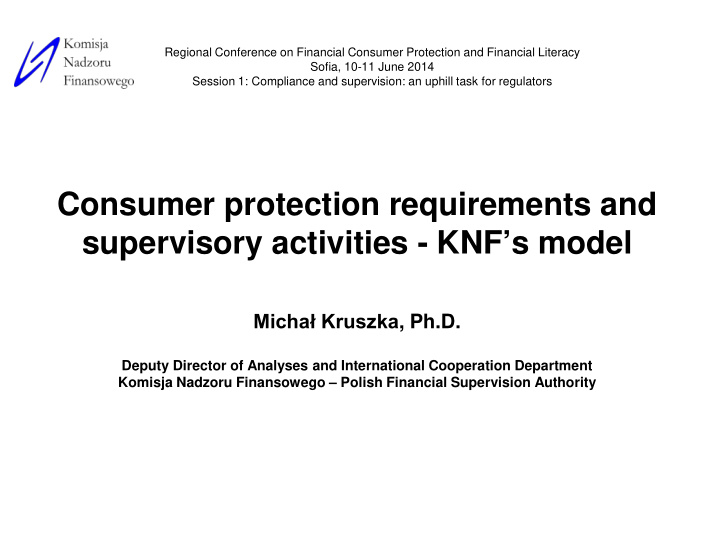



Regional Conference on Financial Consumer Protection and Financial Literacy Sofia, 10-11 June 2014 Session 1: Compliance and supervision: an uphill task for regulators Consumer protection requirements and supervisory activities - KNF’s model Michał Kruszka , Ph.D. Deputy Director of Analyses and International Cooperation Department Komisja Nadzoru Finansowego – Polish Financial Supervision Authority
A few words on the KNF integrated supervisor (all segments of the financial market) sectoral (most) and cross-sector departments one of the statutory objectives: protection of legitimate interests of market participants many areas are regulated by the Office of Competition and Consumer Protection rather than by the KNF
Three complementary mechanisms Communication of supervisory expectations Regular Customer supervision Protection by sectoral Department departments
Communication of supervisory expectations First: KNF interpretations serve to operationalise high-level provisions of legal acts give financial institutions clarity as to what the regulator expects where relevant, take into account guidelines of the ESAs are not legally binding in themselves but their goal is to interprete legal provisions rather than to create autonomous norms examples of issues: investment advice, forex, bancassurance KNF institutions
Communication of supervisory expectations Second: KNF recommendations set out rules that are complementary to those stipulated in legal acts and operate independently set out guidelines on best practices provide for detailed obligations inter alia in the area of consumer protection express supervisory expectations and have no legally binding power, but are generally observed by institutions examples of issues: loan agreements, fx loans, bancassurance KNF institutions
Communication of supervisory expectations Third: education activities for institutions: seminars aimed at enhancing understanding of their obligations for institutions: letters highlighting activities that may constitute a breach of consumer protection law for consumers: campaigns aimed at increasing awareness of risk in the financial market, incl. free communication through public media example: joint campaign on retail loans with the Office of Competition and Consumer Protection and five other public bodies institutions KNF consumers
Communication of supervisory expectations Fourth: public warnings communicating to the public information on legal actions taken against entities that offer financial services without an appropriate license, through the KNF web site and communiques in the media KNF consumers
Regular supervision by sectoral departments carried out by banking, insurance and capital market supervision departments mostly during inspections includes verification of procedures, information systems, and documentation of transactions, as well as interviews with compliance officers and with persons responsible for contacts with clients focused on most risky areas
Customer Protection Department First: complaints from clients More than 10 000 complaints have been filled with the KNF last year. • verification against formal criteria stage 1 • classification to the registry stage 2 • selection of cases to be processed, based on the nature, scale and gravity of the misconduct, as well as on cost-benefit analysis stage 3 • „soft” interaction with the institution: proposing changes to the practices stage 4 • formal actions: supervisory recommendations, decisions and enforcement actions stage 5
Customer Protection Department Second: market surveillance identification and analysis of problematic market phenomena, particularly across sectors analysis of standard contracts used by institutions monitoring of advertisements monitoring of innovations in the financial market taking supervisory actions: from inspections through supervisory recommendations through sanctions
Conciliatory Court supported by the KNF but independent in its decisions allows for conciliatory resolution of cases arising among financial markets participants, mainly between supervised firms and their clients two modes: mediation and arbitrage very limited application: financial institutions usually don’t consent to this form of resolving disputes 2013 saw a revision of the Court’s statute to increase involvement of firms in nomination of arbitrators and mediators an alternative: Banking Consumer Arbitrage supported by the Polish Bank Association
Summary Consumer protection function is executed by the KNF in three ways: through detailed communication with firms and clients, through ordinary sectoral supervision and through dedicated Customer Protection Department. Consumer protection is not a primary task of the KNF as there is a separate authority for these matters. As concluded by the Supreme Audit Office, the KNF properly excercises its powers in the area of consumer protection, but these powers are rather limited.
Thank you. Michał Kruszka michal.kruszka@knf.gov.pl
Recommend
More recommend